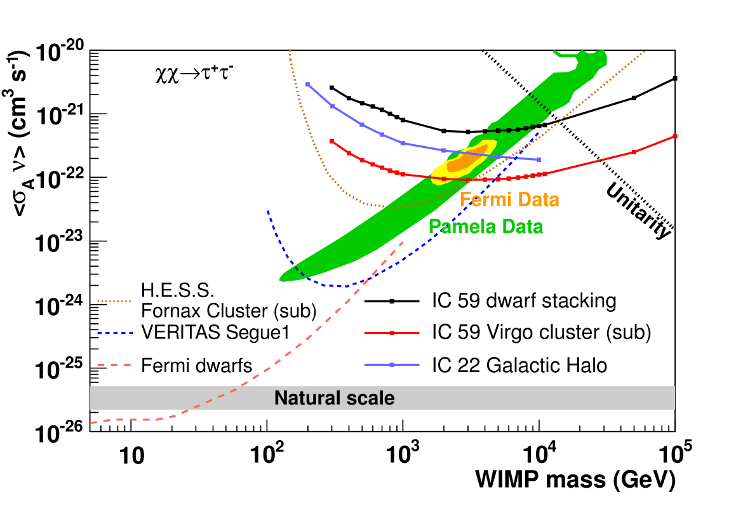Successful cosmological models hold that dark matter accounts for most of the matter effects we observe in our Universe. WIMPs, weakly interacting massive particles, impervious to electromagnetic and strong nuclear interactions, are the category of dark matter candidates with the most devotees among scientists. WIMPs are also predicted by supersymmetric extensions of the Standard Model of particle physics. These models have credence with the physics community but there is no experimental evidence that identifies the composition of dark matter to date.
New results from the IceCube Collaboration set up new limits on the cross section as a function of the WIMP mass for annihilation into
$$ \small b\overline{b},\,W^{+}W^{-},\,\tau^{+}\tau^{-} \; and \; \small \mu^{+}\mu^{-}$$
This is the first search for dark matter annihilation in nearby galaxies and galaxy clusters using a sample of high-energy neutrinos detected with the IceCube Neutrino Observatory during the 2009–10 data-taking period, when the telescope was running in its 59-string configuration. This analysis has been submitted to Physical Review D.


The neutralino, χ0, is currently the hottest particle candidate in the search for dark matter. The lightest of all WIMP supersymmetric particles and its own antiparticle, it is thus expected to annihilate into ordinary particles. Of these, neutrinos, together with photons, are especially interesting since they point back to their astrophysical sources. Cosmic-ray antiprotons and positrons also stand out because background signals are small.
IceCube is looking for signals of such annihilations in the neutrino flux reaching the Antarctic detector. If the predicted dark matter annihilation fluxes exceed IceCube’s detection threshold and are not seen, then the model is excluded. The predicted neutrino flux depends linearly on the velocity averaged annihilation cross section and the squared dark matter density, and is inversely proportional to the squared neutralino mass.
In a recent analysis looking for WIMPs trapped in the Sun, the IceCube Collaboration set the most stringent upper limits yet on the χ0 mass for the spin-dependent hard decay modes. The new search discussed here looks for dark matter in extragalactic sources, such as the Virgo and Coma galaxy clusters, the Andromeda galaxy, and several dwarf galaxies.
Those sources are considered to be dark matter dense regions of our Universe, and previous measurements by several satellite detectors such as PAMELA, FERMI and AMS-02 have yielded interesting results. The three detectors have observed some positron excess at GeV energies in the cosmic ray flux, which, according to theoretical models, could be an indication that dark matter decays do favor leptonic channels.
Despite these measurements, neutrinos reaching IceCube do not show any significant excess from these regions. The measured fluxes, however, set competitive limits for the velocity averaged self-annihilation cross section above 1 TeV.
This exploratory search will be sharpened with the much larger data sample at hand and will be extended to other potential dark matter sources in the near future.
Info “An IceCube search for dark matter annihilation in nearby galaxies and galaxy clusters,” IceCube Collaboration: M.G. Aartsen et al. Physical Review D88 (2013) 122001, arXiv.org:1307.3473 prd.aps.org